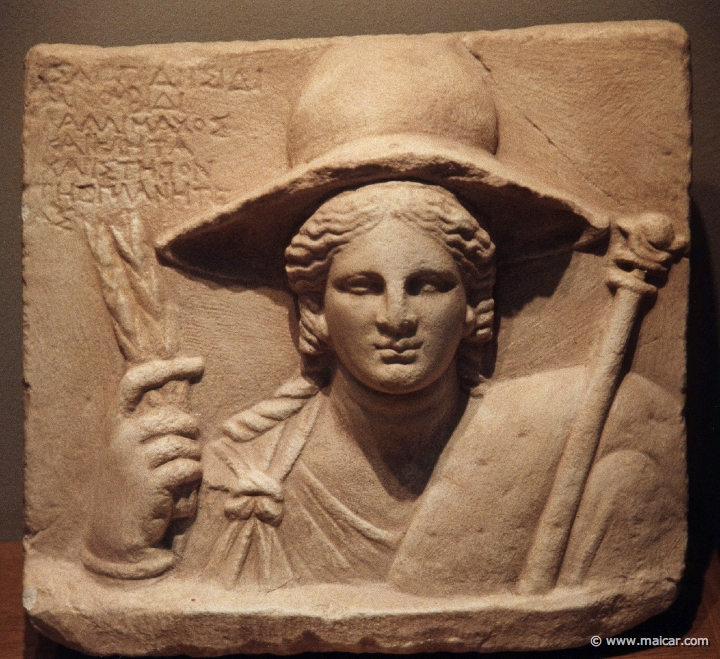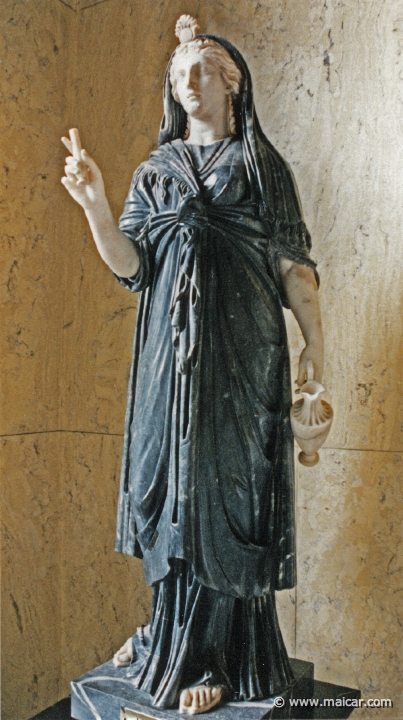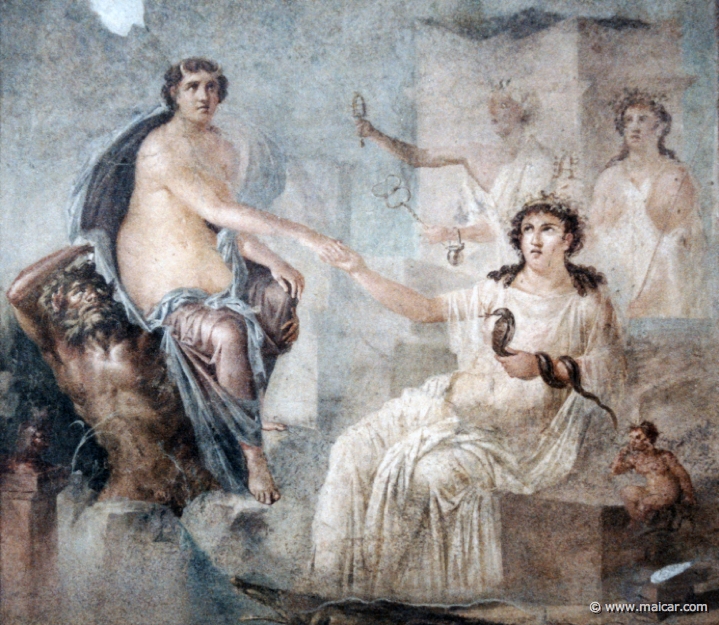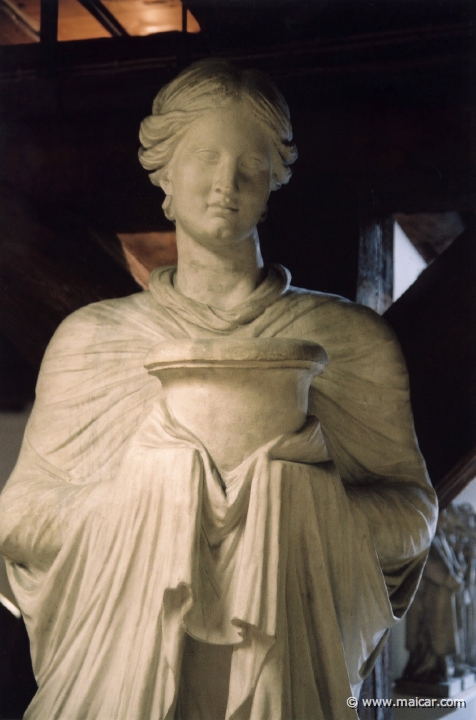|

|
6406: Inscribed plaque depicting the goddess Isis. Dion Museum (Macedonia, Greece), 2C BC.
|
|
|
"Tell me: to what region of the earth I have wandered in my wretchedness?" (Io. Aeschylus, Prometheus Bound 565).
"This god (Zeus), desirous of union with this mortal maid, has imposed upon her these wanderings. Maiden, you have gained a cruel suitor for your hand." (Prometheus 1 to Io. Aeschylus, Prometheus Bound 565).
|
|
Io, who is one of the Three Main
Ancestors, was turned into a cow after having
been seduced by Zeus, and
forced to wander over the whole world until she
settled in Egypt.
Girls do not turn into cows, according to the
Persians
Io is said to have been turned into a cow,
either by Hera or Zeus, and then forced to wander over the whole world. But the Persians, whose wisdom is known by all, did not care a jot for this kind of tales, at least not for this one, and that is why they chose to believe that Io, daughter of Inachus, was seized together with other women by Phoenician merchants, who sailed away for Egypt with the kidnapped women on board. This explanation, they thought, should account for the disappearance of Io from Hellas, since girls do not turn into cows and then vanish.
Chain of affronts
Now, the Persians agreed that the abduction of
Io by the Phoenicians was a wrong that Asia did
against Europe. So when later the Europeans carried
off the Phoenician princess Europa, they say, Asia
and Europe were then even; for they, accepting
again counsel from their wisdom, did not believe in
the tale of Zeus the bull
conveying the princess Europa to Crete through the sea
either. According to the book that the Persians
kept concerning the abduction of women and the
wrongs that Asia and Europe performed against each
other, the Europeans (that is the Greeks, in those
times) then sent the ARGONAUTS to the city
of Aea in Colchis, and carried off the Colchian
princess Medea. That was
the third wrong, they affirm, and when the
Colchians demanded the restitution of Medea, the Greeks answered
that they had been refused reparation for the
abduction of Io. After that, the Trojan seducer Paris decided that he
would make a Greek woman his wife, and taking
lessons from the past, he abducted Queen Helen of Sparta. And since this
had been done several times before him, he feared
nothing.
The greatest wrong
However, on this occasion the method found no
tolerance; for a powerful fleet gathered at Aulis
and sailed to Troy in order
to obtain, by persuasion or by force, the
restoration of Helen and
the property that Paris had taken with him. This was unprecedented, and
even though the Trojans then pleaded the seizure of Medea, war broke out
nevertheless. The Persians think that there is no
reason to go to war for such matters, arguing that
the women would never have been carried away, had
they not wanted it themselves. And that is why they
think that the Greeks did even a greater wrong when
they became the first to stage a huge attack, and
razed a city for the sake of a woman.
|

|
Io as Isis. 0716: Isis. Early 2C AD. Künsthistorische Museum, Wien.
|
|
Another opinion
Now, these discussions being endless, it has
been firmly established by other authors that Io,
who was a priestess of Hera, was not abducted by
Phoenician sailors, but instead was turned into a
cow and forced to leave her country and wander
throughout the world, after having been seduced by Zeus. Some have said (for
authors seldom agree) that Hera, out of jealousy,
turned Io into a cow, but others have affirmed that Zeus made the transformation, swearing that he had not been with the girl. And since this oath was uttered, it has been
believed by all that a lover's oath does not draw
the anger of the gods. That is why, thousands of
years later, Don Quixote dared to say:
"Love and war
are the same thing, and stratagems and policy are
as allowable in the one as in the other." (Miguel de Cervantes, Don
Quixote, Part II, Chapter XXI).
End of Argus 1
When Zeus had thus
disguised Io under the shape of a cow, Hera, suspecting mischief,
requested the cow for herself and set Argus 1, the All-seeing,
to guard the animal. That was the end of the
All-seeing; for Zeus, who
wished to set the cow free, ordered Hermes to steal it, and
this god, following instructions, killed Argus 1 by the cast of a
stone.
First wanderings
This is how the cow went free. But Hera sent a gadfly to
infest and torture it, and so Io, tormented by the
gadfly's sting, began her wanderings, coming first
to the Ionian sea, which is called after her. Then
she journeyed through Illyria, which is the region
north of Epirus in the eastern coast of the
Adriatic Sea, and came to Mont Haemus in Thrace,
and thence she crossed the Bosphorus, which
separates Europe and Asia. Io continued her
wanderings through Scythia and Cimmeria (to
the north of the Black Sea), met in Caucasus the
bound Prometheus 1,
and finally she came to Egypt.
Dreams behind everything
If Io is to be believed, all these things were
caused by dreams. For when she met Prometheus 1, Io
told him that her afflictions began with those
dreams she had had by night, in which visions told
her to leave her maidenhood behind her and yield to Zeus, who loved her. She
also said that, having told these dreams to his
father Inachus, he consulted the oracle, and the
god speaking through it commanded him to banish his
daughter from home and land to roam over the whole
world, adding that, if he disobeyed, a thunderbolt
from Zeus would destroy his
race.
What Inachus did to find her
This Inachus did, says Io. And yet Inachus acted as if he were ignorant of what had happened to his daughter. For he sent Cyrnus 1 to look for her, and this man came as far as Caria, the southwestern region of Asia Minor, and not finding her, settled there. Also Lyrcus 2 is said to have been sent by Io's father to search for her, and after having covered a great deal of land and sea without finding the girl, he finally renounced the quest; but being too afraid of Inachus to return to Argos, he went instead to
King Caunus of Caria, where he married the king's
daughter.
Epaphus 1
|

|
7210: Isis receiving Io in Egypt. Temple of Isis, Pompeii. National Archaeological Museum, Naples.
|
|
In Egypt, the wandering girl recovered her human
form and gave birth to Zeus' son Epaphus 1 beside the river Nile. Hera then
bade the CURETES to steal the child; and having
obeyed the goddess, they were killed by Zeus for having carried out his wife's orders. It was then that Io started her new wanderings, this time in search of her son. And after roaming all over Syria, she found Epaphus 1, who had been nursed by the wife—called by some Astarte and by others Saosis—of King Malcander of Byblus. Together with her son she returned to Egypt, and married Telegonus 1, who at the time reigned over the Egyptians. This is why Epaphus 1, from whom sprang the Libyans and the Ethiopians, became later king of Egypt, and the founder of the city of Memphis.
Io-Isis
Having thus settled in Egypt, Io made a statue
of Demeter, and this goddess was then called Isis. And after that, the Egyptians also gave Io the name Isis, and Io-Isis, they say, was made a goddess by Zeus. Isis is known for having mourned the god Osiris 1, worshipped by the Egyptians, who affirm that Isis discovered many drugs, and was versed in healing, giving aid during sleep while standing above the sick. They say that many who had lost the use of their eyes, or other part of their body, were restored to their previous condition whenever they turned for help to Isis. They call Apollo her son,
and they say that it was Isis who instructed him in
healing and divination. The Drug of Immortality,
which achieves the highest form of healing, was
discovered by Isis, but the formula remains unknown
for the majority of men, as anyone can notice by
himself.
Telethusa
As reported, Isis appeared in the dreams of the Cretan woman Telethusa, whose husband Lidgus wished to have their child killed, would Telethusa give birth to a girl. But when the child was about to be born, Telethusa had a vision in her dreams in which Isis, in the company of other gods (Anubis, Bubastis, Apis 1, Harpocrates and Osiris 1), told her not to obey her husband's orders. Doing as the vision ordained, she then disguised her daughter as a boy, thus deluding her husband. Later, this girl, when she was about to marry, became a boy.
|

|
Priestess of isis. 8831: Stående Isis praest, restaureret som praestinde med krukke. Fra Hadrians villa i Tivoli. Romersk, 2. årh e. Kr. Hovedet graesk? 2. årh f. Kr. Rom, Museo Capitolino (Royal Cast Collection, Copenhagen).
|
|
Fish saves Isis
Isis is said to have been once saved by a fish,
and for this reason the fish was put among the
constellations, being the one Fish that is called
southern, which seems to drink from the
constellation of Aquarius. This is the reason why,
some say, the Syrians do not eat fish; but others
assert that it is because the goddess Derceto (whom
some call Astarte) threw herself in a lake near the
city of Ascalon, and was changed, as to the form of
her body, into a fish. Since that day then, the
Syrians do not eat fish, and honour their fishes as
gods.
Invocation of Lucius Apuleius
Isis came to be worshipped in a large part of
the world as a great goddess, and her manifold
nature becomes apparent in Apuleius' invocation,
when he says:
"Blessed Queen of Heaven,, whether you are pleased to be known as Ceres (Demeter). … who in joy at the finding of your lost daughter Proserpine (Persephone). … gave our forefathers bread raised from the fertile soil of Eleusis; or whether as celestial Venus (Aphrodite). … who at the time of the first Creation coupled the sexes in mutual love … or whether as Artemis, the physician sister of Apollo, reliever of the birth pangs of women, and now adored in the ancient shrine at Ephesus; or whether as dread Proserpine (Persephone). to whom the owl cries at night, whose triple face is potent against the malice of ghosts … you who wander through many sacred groves, and are propitiated with many different rites … I beseech you (etc.)." (Apuleius, The
Golden Ass).
And the goddess answers him in similar way:
"The Phrygians call me … Mother of the Gods; the Athenians, call me Cecropian Artemis; for the islanders of Cyprus I am
Paphian Aphrodite; for the archers of Crete I am Dictynna; for the Sicilians Proserpine (Persephone).; and for the Eleusinians their ancient Mother of the Corn (Demeter). Some know me as Juno (Hera), some as Bellona of the Battles, others as Hecate … and the Egyptians … call me by my true name, namely, Queen Isis." (Apuleius, The
Golden Ass).
Io is one of the Three Main
Ancestors
Ancestors and founders of important cities like Mycenae, Thebes, and Argos were descendants of
Io (or the river god Inachus). These dominated also Crete,
Laconia, and perhaps Arcadia. The HERACLIDES were
descendants of Io. So were, among others, Cadmus, Perseus 1, and Heracles 1.
|